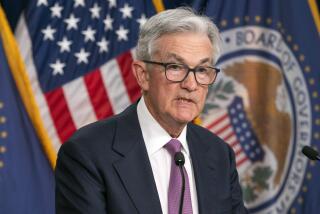Fed holds steady on interest rates and stimulus, sees risks easing
WASHINGTON -- Federal Reserve policymakers said Wednesday that they would continue the central bank’s controversial bond-buying stimulus program and leave short-term interest rates near zero to help boost the economic recovery, which they said was facing fewer downside risks.
Members of the Federal Open Market Committee said they were seeing some improvement in the recovery and slightly upgraded their forecast for the labor market.
In Wednesday’s statement, Fed policymakers said it saw “the downside risks to the outlook for the economy and labor market as having diminished since the fall.”
QUIZ: How much do you know about sequestration?
Fed policymakers said unemployment could drop to as low as 7.2% this year and 6.5% in 2014. The previous forecast, in March, had the unemployment rate falling to no lower than 7.3% this year and 6.7% next year.
The 6.5% figure is important because that’s a key threshold the Fed has set for short-term interest rates. The Fed reiterated Wednesday that it would keep the rate at near zero as long as unemployment remains above 6.5% and inflation remained in check.
But while the labor market outlook improved, the Fed downgraded its projections of economic growth this year to no more than 2.6% from an earlier forecast of as high as 2.8%.
The Fed projects growth to improve next year to as much as 3.5%, up from the 3.4% forecast high in March.
The Fed has been providing unprecedented levels of stimulus to the economy, in the form of rock-bottom interest rates and bond-buying, since 2008. The latest program, launched in September, involves purchasing $85 billion in bonds each month to try to keep long-term interest rates low.
As the economy has shown signs of improving, pressure is growing on the Fed to scale back its stimulus efforts to avoid fueling inflation and possible new asset bubbles.
But financial markets are skittish about when and how the Fed will start reducing its bond-buying, and recent comments by central bank officials that it could happen soon have fueled a rise in long-term interest rates.
Fed Chairman Ben S. Bernanke said in May that the central bank could begin tapering its monthly purchases within a few months.
ALSO:
Investors on edge before Fed meeting
Era of falling interest rates appears to be over
Three things to watch for from the Fed and Bernanke on Wednesday
More to Read
Inside the business of entertainment
The Wide Shot brings you news, analysis and insights on everything from streaming wars to production — and what it all means for the future.
You may occasionally receive promotional content from the Los Angeles Times.











